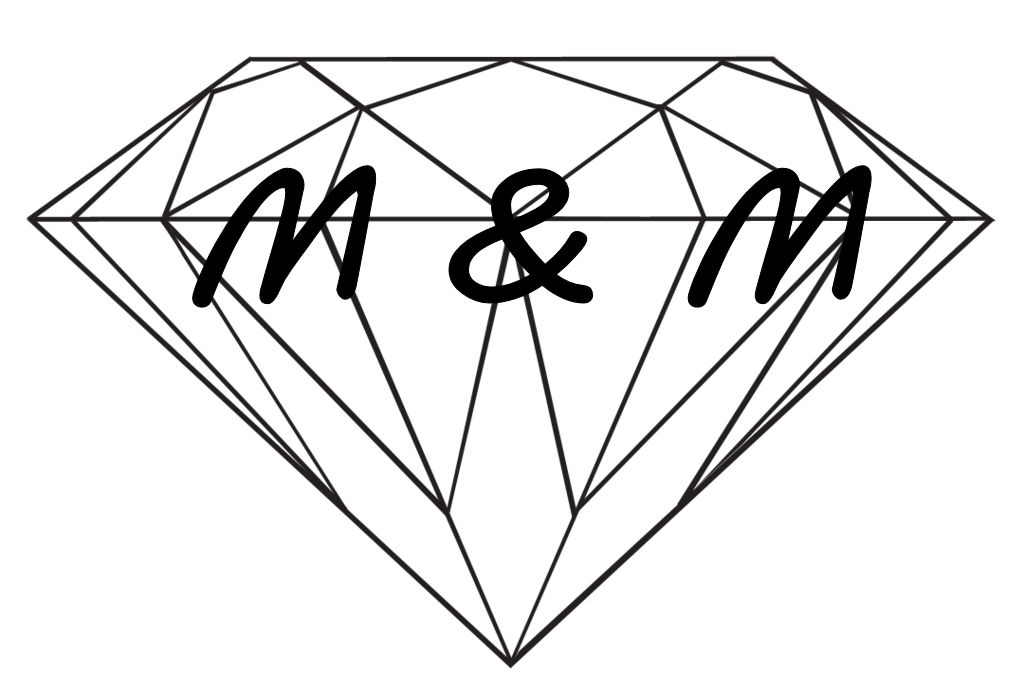Diamond Education
The 4 C's(Clarity, Cut, Color, Carat)
Diamond Anatomy
Diamonds seem to be everybody’s friend, and most discussions start and can end around diamonds. Although our interests surround all jewelry, at M&M, we understand and support the interest in diamonds, so hope to offer a brief introduction to this fascinating topic.
The diamond industry can be separated into two distinct categories: one dealing with gem-grade diamonds and another for industrial-grade diamonds. Industrial diamonds are valued mostly for their hardness and thermal conductivity. Up to 80% of all mined diamonds are unsuitable for use as gemstones and so are used industrially. The remainder are gem grade and are our primary interest.
The information presented below is meant as a brief overview, starting with the ideal cut, one that reflects light from a source back out to the source. Different cuts are necessary to insure the light that goes into a stone will reflect back out, and every part of a cut stone has its own name.


Understanding the 4 C’s of Diamonds Shopping
You’ve probably heard about the 4Cs of a diamond, and you may even know that it stands for Clarity, Cut, Color and Carat Weight. Below, we talk in depth on all four.
Clarity
Natural diamonds are the result of carbon exposed to tremendous heat and pressure deep in the earth. This process can result in a variety of internal characteristics called ‘inclusions’ and external characteristics called ‘blemishes’. Diamonds without any inclusions or blemishes are exceedingly rare; however, most characteristics can only be seen with magnification.


Diamond Clarity Discussion
Inclusions are solids, liquids, or gases that were trapped in a mineral as it formed. They may be crystals of a foreign material or even another diamond crystal, or may have produced structural imperfections, such as tiny cracks that make a diamond appear whitish or cloudy. The number, size, color, relative location, orientation, and visibility of inclusions can all affect the relative clarity of a diamond. A clarity grade is assigned based on the overall appearance of the stone under ten times magnification.
Most inclusions present in gem-quality diamonds do not affect the diamonds’ performance or structural integrity and are not visible to the naked eyes. However, large clouds can affect a diamond’s ability to transmit and scatter light. Large cracks close to or breaking the surface may reduce a diamond’s resistance to fracture.
Diamonds with higher clarity grades are more valued, with the exceedingly rare “Flawless” graded diamond fetching the highest price. Please note minor inclusions or blemishes are useful, as they can be used as unique identifying marks analogous to fingerprints. In addition, as synthetic diamond technology improves and distinguishing between natural and synthetic diamonds becomes more difficult, inclusions or blemishes can be used as proof of natural origin.
Cut
Of all the 4Cs, Cut has the greatest effect on a diamond’s beauty, it is the most complex and technically difficult to analyze. In determining the quality of the cut, the diamond grader evaluates the cutter’s skill in the fashioning of the diamond. The more precise the cut, the more captivating the diamond will be to the eye.


Diamond Cut Discussion
A diamond cut is a style or design guide used when shaping a diamond for polishing such as the brilliant cut. Cut does not refer to shape (pear, oval), but the symmetry, proportioning and polish of a diamond. The cut of a diamond greatly affects a diamond’s brilliance; this means if it is cut poorly, it will be less luminous.
In order to best use a diamond gemstone’s material properties, a number of different diamond cuts have been developed. A diamond cut constitutes a more or less symmetrical arrangement of facets, which together modify the shape and appearance of a diamond crystal. Diamond cutters must consider several factors, such as the shape and size of the crystal, when choosing a cut.
The most popular of all diamond cuts is the modern round brilliant, whose facet arrangements and proportions have been perfected by both mathematical and empirical analysis. A diamond’s cut is evaluated by trained graders, with higher grades given to stones whose symmetry and proportions most closely match the particular “ideal” used as a benchmark. The strictest standards are applied to the round brilliant; although its facet count is invariable, its proportions are not.
Color
The color evaluation of most gem-quality diamonds is based on the absence of color. A chemically pure and structurally perfect diamond has no hue, like a drop of pure water, and consequently, a higher value. They can range from colorless to light yellow or light brown. Colorless diamonds are the rarest. Other natural colors (blue, red, pink for example) are known as “fancy,” and their color grading is different than from white colorless diamonds.


Diamond Color Discussion
A chemically pure and structurally perfect diamond is perfectly transparent with no hue, or color. However, in reality almost no gem-sized natural diamonds are absolutely perfect. The color of a diamond may be affected by chemical impurities and/or structural defects in the crystal lattice. Depending on the hue and intensity of a diamond’s coloration, a diamond’s color can either detract from or enhance its value. Of all colored diamonds, red diamonds are the rarest.
Diamond colors are graded alphabetically, with ‘D’ being considered colorless, and ending in ‘Z’.
Carat (Weight)
Carat weight is the most objective grade of the 4Cs and is the measurement of how much a diamond weighs, even though most people think of carats as a measure of size.


Diamond Sizing Descriptions
The carat is the diamond’s physical weight measured in metric carats, which is defined as 200 milligrams.
Each carat can be subdivided into 100 ‘points.’ This allows very precise measurements to the hundredth decimal place. A jeweler may describe the weight of a diamond below one carat by its ‘points’ alone. For instance, the jeweler may refer to a diamond that weighs 0.25 carats as a ‘twenty-five pointer.’
